Source: Smart Connected Vehicle Network
Introduction:
Discussing the Internet of Vehicles
First, let’s talk about the concept of the Internet of Vehicles. Simply put, it refers to the wireless communication and information exchange between vehicles and the internet through wireless communication devices, enabling the information network platform to extract real-time static and dynamic data from vehicles, ultimately achieving intelligent vehicle control.
Therefore, the ultimate direction of the development of the Internet of Vehicles is intelligent connected vehicles and vehicle-road cooperation.
Intelligent connected vehicles must have the ability to perceive, exchange information, and provide services.
The perception capability includes both internal and external perception. Internal perception involves sensors installed inside the vehicle to monitor the vehicle’s operational status and the driver’s condition; external perception involves acquiring information about the surrounding road environment through sensors such as radar, cameras, and GPS.
The capacity for information exchange includes the ability to connect to the internet for intelligent vehicle control and intelligent traffic control (vehicle-network interconnection) and the ability to connect with other vehicles to implement collision warnings, automatic obstacle avoidance, maintaining safe distances, and sharing road conditions (vehicle-vehicle interconnection).
The service capability of intelligent connected vehicles is reflected in the vehicle-road interconnection capability, which allows for connections with roadside devices to achieve transport management, speed guidance, signal control, construction zone alerts, etc.
Vehicle-road cooperation aims to achieve intelligent collaboration and coordination between vehicles and roads, making full use of the spatiotemporal resources of the traffic system to reduce accidents and save energy. According to the results of the U.S. Safety Pilot project, vehicle-road cooperation can reduce accident rates by 44%; the “U.S. NHTSA Research Report” mentions that vehicle-road cooperation technology can achieve a 39% reduction in energy consumption.
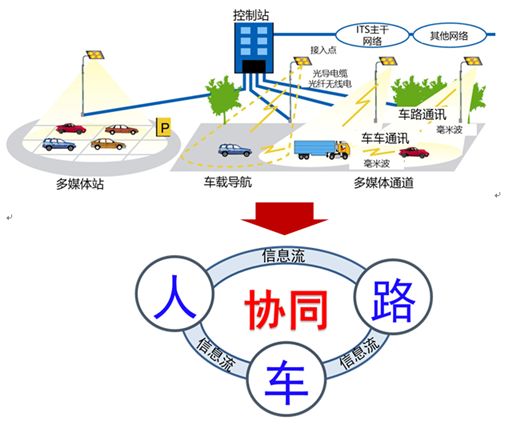
Vehicle-Road Cooperation Architecture
The drawback of existing transportation methods is that people adapt to the system; there is an urgent need to shift from a “people-adapting system” to a “system-adapting people”.
For example, traveling from Beijing to Qingdao requires booking a flight, determining the flight time, and arriving at the station on time. We are all adapting to the transportation system. Imagine a scenario where the transportation system adapts to people; that would be true artificial intelligence, closely integrated with transportation.
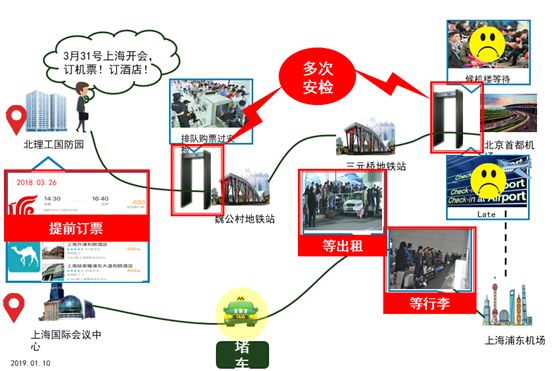
People-adapting systems face many challenges. For instance, traveling from Beijing to Shanghai is not easy; one must book tickets in advance, arrive at the subway station, go through security checks, and then get to Pudong Airport. After landing, one must check if someone is picking them up; if not, they have to take a shared bike to the venue. This entire process requires advance ticket purchases, early arrivals, waiting, rescheduling, multiple security checks, waiting for luggage, hailing taxis, and dealing with traffic jams, all of which require people to adapt to the transportation system.
We envision a time when the system adapts to people. What does it mean for the system to adapt to people? Simply put, it means that every individual can receive a customized integrated transportation plan when traveling.
For example, when traveling from Beijing to the Qingdao Conference Center, I buy one ticket, and a packaged transportation plan is generated. For instance, Plan 1 is the shortest time, while Plan 2 is the lowest cost. After selecting a plan, one can travel seamlessly, going through security checks at one station, with direct access to real-time flights or high-speed trains. Upon arrival, luggage is transported by a dedicated vehicle, and in Qingdao, shared taxis are arranged based on the system detecting the vehicle carrying the luggage and friends going to the conference center, ensuring direct delivery to the destination. The vehicle-road cooperation system ensures there are no traffic jams.
Everyone enjoys customized or diverse personalized services; this is what we mean by “the transportation system adapting to people.” The artificial intelligence combined with transportation and the Internet of Vehicles is in this sense; it fundamentally changes our understanding of transportation, moving away from the traditional concept of people adapting to the transportation system.
Future Transportation Technologies
Can the aforementioned system-adapting people scenario be realized? Currently, it seems possible. Why? Because of N (Network), B (Big Data), and A (Artificial Intelligence). This represents the deep integration of the new generation of information technology with comprehensive transportation.
Specifically, it involves intelligent transport tools that are networked and autonomous, collaborative and intelligent infrastructure, and knowledge-based, personalized intelligent operational services. This is how we drive into a smart transportation society.
Sky, Ground, and Space Network
First, data collection is crucial; all information must be perceived, requiring an integrated sky-ground network to establish good network conditions for collecting all information.

Networked System Structure: Faster, More Comprehensive, More Accurate Data Collection/Operational Decision-Making
Big Data
Big data can be used to gain insights, understand, and predict the evolutionary laws of complex transportation systems, allowing us to know where congestion occurs and where it does not, thereby enabling detection.
Therefore, comprehensive infrastructure for big data must be well established, including the ability to achieve EB-level data centers, PB-level network applications, and servers capable of handling hundreds of billions of records of massive data; systems for high and low value data analysis and display that can handle air traffic control instructions, passenger ticket information, and monitoring images; as well as cross-domain system integration, including government resource sharing, network resource aggregation, and system interconnection.
Only with solid infrastructure can we achieve a multidimensional, comprehensive intelligent transportation system that evaluates energy consumption, public health, air pollution, and more; presents data more intuitively; ensures data accuracy; and provides deeper insights.
Customized Services
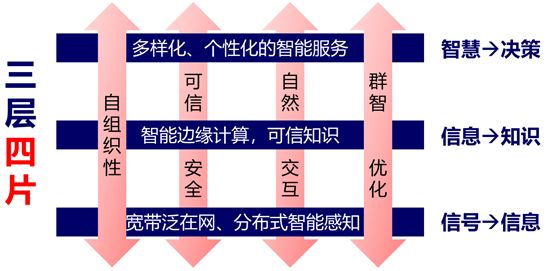
Three Layers and Four Pieces Architecture
To realize customized transportation services, we can adopt a theoretical architectural system of “three layers and four pieces”.
First, let’s discuss the “three layers”.
The first layer is the bottom layer shown in the above image, which collects all relevant transportation information and transforms signals into information.
The second layer utilizes intelligent edge computing because future vehicles will achieve the integration of industrialization and informatization, with 5G being the most empowering technology. The combination of 5G and new energy vehicles can transform into industrial IoT, where a supercomputer can be integrated into this vast network, and the computing at the vehicle terminal belongs to edge computing. With intelligent edge computing, we can transition from information to knowledge, and that knowledge can be trusted.
In the third layer, we can truly achieve wise decision-making and services, fully diversified.
In summary, the first layer is generalized perception, the second layer is edge networked computing, and the third layer is ubiquitous intelligent services.
What technologies are needed to support these three layers? This leads us to the “four pieces”.
First, the system must be self-organizing, meaning that this distributed hierarchy must be able to organize itself; it must also be trustworthy and secure, capable of natural interaction, and ultimately achieve collective intelligence and optimization.
Once we implement the “three layers and four pieces,” transportation will undergo revolutionary changes, ultimately achieving precise time allocation – minute-level, precise spatial allocation – meter-level, and optimal service allocation – individual-level.
For instance, the transportation modes we use today are measured in hours; in the future, they will be measured in minutes. Our transfers, such as taking the subway, will be measured in hundreds of meters, and using shared bikes or taxis will also be tens of meters; in the future, they will be meter-level. The services we enjoy will no longer involve hundreds of people on a flight but rather personalized services for each individual.
Here, I will elaborate on the three major characteristics of customized services.
Characteristics of Customized Services – Precision

Flexible Planning and Multidimensional Integration
How can we achieve “precision”? With flexible planning and multidimensional integration, we can obtain real-time information on weather and traffic conditions across large areas. Through big data system calculations, we can carry out multidimensional planning integration, allowing our travel plans to be dynamically adjusted. This enables intelligent time allocation across land, sea, air, and space. Ultimately, the resolution of our travel plans can shift from day/hour-based to minute-based. This represents precision in terms of time.
Characteristics of Customized Services – Accuracy

On-Demand Matching and Cross-Usage
The second characteristic of customized services is to achieve spatial “accuracy”. By utilizing intelligent technology to empower railways, highways, and waterways, we can achieve intelligent or unmanned operations, such as autonomous vehicles, unmanned trucks, and unmanned aircraft. These intelligent or unmanned transport tools can collaborate intelligently and achieve integrated precision matching across multiple modes of transport. Ultimately, this will solve the last mile problem, allowing for spatial resolution of travel itineraries to shift from kilometer-level to meter-level.

Small-scale (weather, traffic status) perception -> Knowledge graph construction -> Transport tool indexing
Characteristics of Customized Services – Optimization

Combination Optimization and Human-Machine Interaction for Personalization
The third characteristic of customized services is “optimization”. Here, we intelligently optimize transportation objects, enabling personalized recommendations online and offline, as well as diverse interactions. This makes it possible to achieve the goal of a personalized transportation system adapting to people, transitioning from group-level service resolution to individual-level.
From the Internet of Vehicles to the Smart Internet
As previously mentioned, the combination of artificial intelligence and the Internet of Vehicles has revolutionized our understanding of transportation. Originally, we adapted to transportation systems; now, transportation systems can adapt to us. Once transportation systems adapt to people, our transfer times can be reduced to minute-level, walking distances to meter-level, and our travel can shift from group-based to personalized. Everyone can afford to take off. This is the impact of artificial intelligence on the Internet of Vehicles.
Next, let’s discuss the industrial smart internet, which is not my main area of expertise, so I will be brief.
First, let’s look at the main stages of industrial networking technology, as shown in the following image.
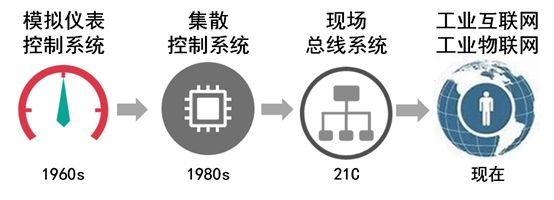
The focus of technological development is on the process informationization and automation of industrial sites.
Currently, the utility of the industrial smart internet is still quite distant, but its integration with the transportation sector is the fastest application. So what is the greatest common divisor between the smart internet and the Internet of Vehicles?
We discuss the industrial internet as transitioning from the consumer domain to the industrial domain; in the transportation sector, we refer to people, vehicles, and roads, while in the industrial sector, we refer to people, equipment, and data. Both are centered around three elements with people at the core, which is the greatest common divisor.
We also need to consider three layers: network, computation, and service.

Regardless of perception collection, equipment management, or data services, the industrial internet indeed faces challenges, such as the inability to connect on demand, lack of knowledge analysis, and insufficient service capabilities. How can these issues be addressed? Deep integration, etc., will not be discussed here.
The following image is my original creation, encompassing the three layers of network, computation, and service. After collecting data through network perception, adding intelligent computation yields information, which is intelligent perceptual information; the second layer involves computation, which should be automated. If we incorporate knowledge into the perceptual computation, we can transform this edge computing from information to knowledge; the third layer is service, where most discussions revolve around applications. If we combine intelligent services with applications, we achieve wisdom. Thus, we transition from network perception to knowledge to service, transforming into information, knowledge, and wisdom. Therefore, the biggest distinction between the industrial internet and the industrial smart internet lies in four words: one emphasizes knowledge, and the other emphasizes intelligence, which are the two main differences.

Look at the following image; isn’t it highly similar to the Internet of Vehicles? This is because I research integrated transportation, so I believe the Internet of Vehicles and the smart internet can find the greatest common divisor that supports our smart internet.
Therefore, I have modified the previous three layers and four pieces to A1 to A3 and B1 to B4. A1 to A3 still represent network, computation, and service, but the context has changed; the network has become intelligent perception, computation has become knowledge computation, and service has become wisdom service.
What does perception mean? Perception involves a ubiquitous, broadband network and distributed intelligent sensing; intelligent edge computing and autonomous knowledge acquisition constitute knowledge computation; and diversified and personalized wisdom service represents wisdom service.
How can we achieve this? We must solve four key technologies: B1 is self-organization of networks and information, B2 is information trustworthiness, B3 is natural interaction and virtual-physical interaction (which is currently a major issue), and B4 is collective intelligence decision-making. Therefore, the core of the industrial smart internet is ubiquitous intelligence and autonomy.
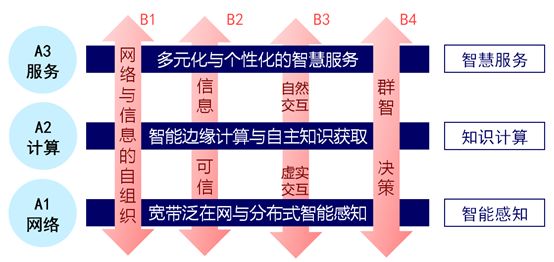
A1 network refers to the broadband ubiquitous network and distributed intelligent perception, meaning that the industrial smart internet’s foundation is broadband, ubiquitous, and autonomous perception; A2 computation refers to edge intelligent computation and autonomous knowledge acquisition, indicating that the industrial smart internet’s computing feature is data to knowledge; A3 service refers to diversified and personalized wisdom service, which is the goal of the industrial smart internet: to provide personalized wisdom services; B1 refers to the self-organization of networks and information, indicating that the industrial smart internet’s physical layer is resource self-organization; B2 refers to information trustworthiness, indicating that the industrial smart internet is a trustworthy environment, potentially using blockchain; B3 refers to natural interaction and virtual-physical interaction, indicating that the industrial smart internet’s intelligent expression is centered on human interaction; B4 refers to collective intelligence decision-making, indicating that the essence of the smart internet is the integration of human, machine, and environment.
Intelligent Connected Transportation Network
From the Internet of Vehicles to the smart internet, the ultimate goal is to achieve an autonomous transportation system, transitioning from data interaction, information accumulation, and passive service across the three layers of network, computation, and service to information interaction, knowledge accumulation, and proactive service.
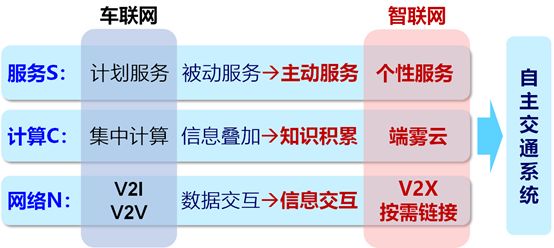
What does autonomous transportation look like? The following image is very important.
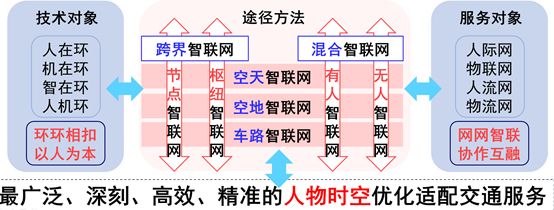
In this image, we first look at the technological objects, the most important aspect being the transition from the left box to the right box. The left box represents the human-environment, machine-environment, and intelligence-environment, where the human-machine environment is interconnected. The right box represents the interpersonal network, the internet of things, the human flow network, and the logistics network, all interconnected.
The vehicle-road smart internet is the foundation, but we also need to extend beyond the ground to include the air-ground smart internet and the air-space smart internet, ensuring that the entire space is filled with networks, providing a three-dimensional network that guarantees signal acquisition anytime and anywhere. The left side represents the infrastructure within the smart internet, divided into node-based smart internet and hub-based smart internet; since we cannot transition to an unmanned network all at once, it is a gradual process. The right side illustrates a hybrid smart internet that combines manned and unmanned elements.
Vehicle-Road Smart Internet
The vehicle-road smart internet operates through the collaboration of intelligent vehicles and intelligent roads.
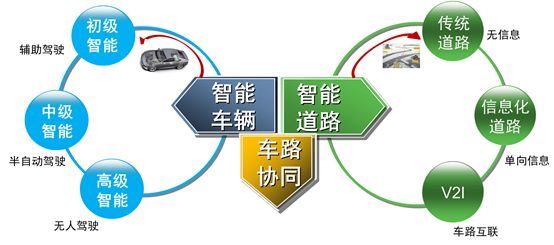
Air-Ground Smart Internet

Air-Space Smart Internet
Additionally, let’s discuss the air-space smart internet. In the future, traveling in the air will be similar to ground transportation, requiring smart tracks, companion flying, safety monitoring, task reconstruction, and personalized travel, which may be a reality after 2050.
Logistics Smart Internet
Next, let’s briefly discuss the cross-domain smart internet, starting with logistics. In the future, logistics will involve four As: you receive information at any time, on any route, and in any manner, allowing you to receive information while on the move, such as during meals when deliveries arrive. This represents a new, intelligent logistics model.
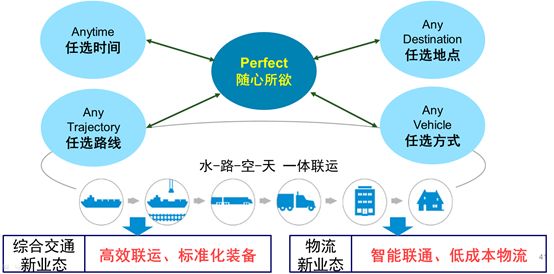
New Patterns of Integrated Transportation Logistics
Hub Smart Internet
Transportation hubs will transition from data to information, knowledge, automation, intelligence, and ultimately wisdom, enabling autonomous vehicles, waterborne helipads, and any location to serve as a stop, all governed by intelligent rules. This will facilitate on-demand capacity and seamless scheduling.
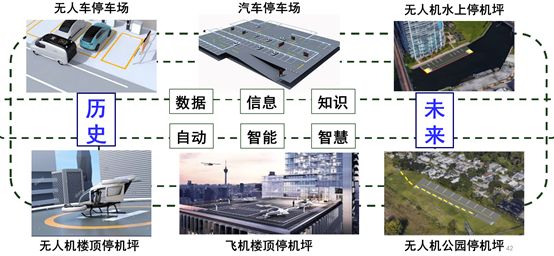
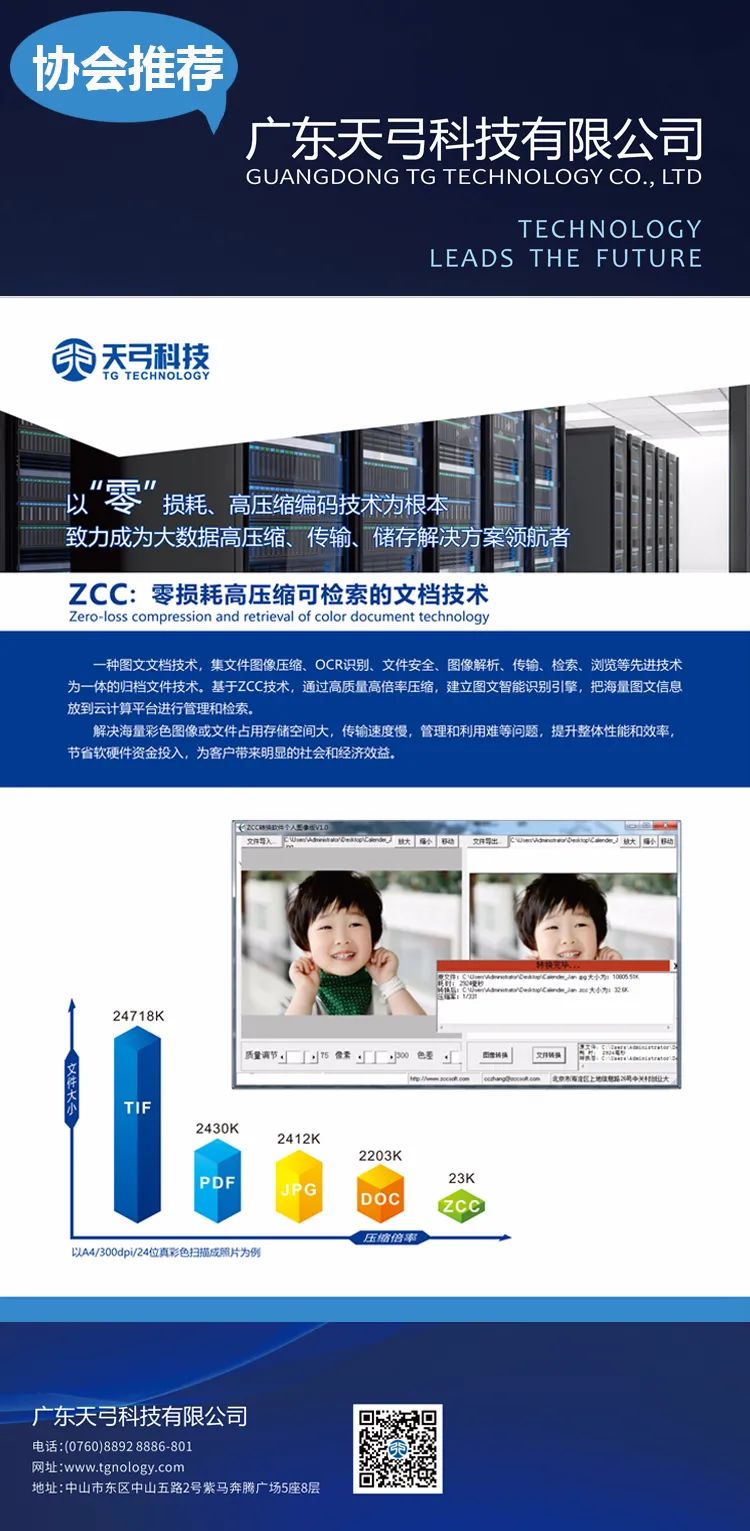
-
《【Association News】2019-2020 Research Tour into the Pearl River West Industrial Belt – Visiting Prinx Chip, Weima Technology, Tsinghua Science Park (Zhuhai)》
-
《【Association News】2019-2020 Research Tour into the Pearl River West Industrial Belt – Visiting Harbin Institute of Technology Robot Group (HRG) Zhongshan Innovation Base》
-
《【Association News】2019-2020 Research Tour into the Pearl River West Industrial Belt – Visiting Fuhua Heavy Industry, Futongda》